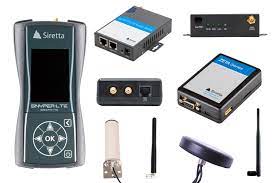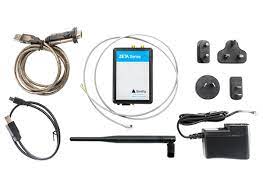-
Cellular network analysers: SNYPER handheld 5G/LTE/LTE-M/NB-IoT/2G survey tools; SENTRY remote analyzers with CloudSURVEY for unattended logging and performance tests. Siretta Limited+2Siretta Limited+2
-
Industrial cellular routers (QUARTZ series): 5G and LTE routers with gigabit Ethernet, dual-SIM/GNSS options, designed for reliable remote connectivity in harsh environments. Siretta Limited+2Siretta Limited+2
-
Industrial modems & gateways: ZETA LTE/LTE-M/NB-IoT modems and SL500 “SirettaLINK” intelligent RS-232/USB serial gateways with cloud configuration/management.
Siretta cellular network analysers & antennas

Siretta — Industrial Cellular Connectivity & RF for IoT
Siretta is a UK-based manufacturer of industrial cellular connectivity solutions for IoT—spanning handheld and remote cellular network analysers, rugged 5G/LTE routers, intelligent modems/gateways, and a broad RF antenna portfolio, all backed by cloud tools for deployment and fleet management. Semix is Siretta’s authorized distributor in Israel.
Antennas (RF) FAQ:
Q1: Which Siretta antenna should I choose for my IoT device?
A: Match the antenna to the device’s bands (5G/LTE, GNSS, Wi-Fi/Bluetooth, ISM), installation style (terminal/puck/adhesive/magnetic), and environment (IP rating). Semix (www.semix.co.il) helps you select the right model and cable/connector.
Q2: What is antenna gain and why does dBi matter?
A: Higher dBi focuses energy for longer range but narrows the radiation pattern—great for fixed assets, less ideal for highly mobile devices. Semix can balance gain vs. coverage for your use case. (General RF principle; product families cover varied gains.)
Q3: Do I need a ground plane?
A: Many compact cellular/Wi-Fi/GNSS antennas benefit from a ground plane for stable tuning and efficiency; Semix will advise based on your enclosure and antenna style. (Siretta provides anechoic test data to guide integration.)
Q4: What about cable loss and connector types?
A: Keep cables short and choose low-loss types; select the right connector (SMA, RP-SMA, N-Type, etc.) to avoid mismatch. Semix supplies ready-made RF cable assemblies to fit Siretta antennas and your device.
Q5: Are Siretta antennas tested/verified?
A: Yes—Siretta antennas are independently tested in calibrated anechoic chambers, with results published in datasheets—Semix can share the right curves for approval.
Q6: Can I use one antenna for multiple radios (5G + Wi-Fi + GNSS)?
A: Yes—Siretta offers multi-band options; for MIMO/cellular diversity you’ll typically need multiple elements. Semix will map antenna count and placement to your radio design.
Cellular Network Analyzers (SNYPER / SENTRY)- FAQs
Q7: What does a cellular network analyzer do?
A: It surveys nearby networks (5G/LTE/LTE-M/NB-IoT/2G), reporting signal metrics and cells to help you pick the best operator and location for your IoT deployment. Semix supports site surveys in Israel.
Q8: What’s the difference between SNYPER and SENTRY?
A: SNYPER is a handheld, battery-powered analyzer for walk-tests; SENTRY is a remote unit for unattended, repeatable surveys with cloud control/reporting. Semix can recommend which suits your roll-out.
Q9: Can results be mapped and shared?
A: Yes—upload SNYPER/SENTRY surveys to CloudSURVEY to visualize approximate base-station positions, compare operators, and export reports for teams and customers. Semix provides onboarding.
Q10: Do analyzers transmit or need a SIM?
A: They passively analyze signals; some models can optionally run performance tests on a registered network (which may require a SIM). Semix will advise per model and use case.
Q11: Which cellular technologies are supported?
A: Model-dependent coverage spans 5G, LTE, LTE-M, NB-IoT, 3G, and 2G. Semix will match the right analyzer to your target technologies and regions.
Q12: How long does a handheld survey last on battery?
A: SNYPER units are handheld and operate for several hours between charges, depending on usage—Semix can advise battery best practices for long site days.



